First Aid
Texas has some rugged country and you may find yourself hunting in remote locations. Most injuries that occur while hunting are due to falls or slides. Knowing the basics of First Aid and CPR will help you deal with emergency situations.
Warning, Hunters - this is only a field guide to treat minor injuries or emergencies. It's the hunter's responsibility to attend a Certified First-Aid and CPR Course.
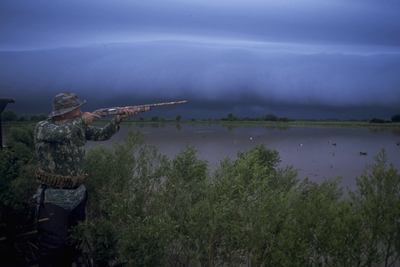
Hypothermia
Hypothermia is a condition where the entire body loses heat faster than it can be produced or retained. The core temperature of the body can fall to a point where the person will die if proper care is not given. Cold and wet conditions, such as rain, snow, and being immersed in water, can induce hypothermia. The air temperature does not have to be below freezing for hypothermia to occur, especially if the person is wet and it is windy. Hypothermia can happen when the temperature is as high as 50 degrees Fahrenheit.
Signs & Symptoms
- Early
- Shivering begins
- Apathy
- Clumsiness
- Slurred speech
- Stiff fingers
- Stumbling
- Strange behavior
- Late
- Obvious mental deterioration
- Incoherence
- Unconsciousness
Treatment in the Field
Call 9-1-1 immediately to get emergency medical services (EMS) on the way.
In the meantime, raise victim's body temperature with dry clothing, shelter, insulation (sleeping bag, blankets etc.) & applied heat (hot water bottles, your own warm body). Exercise caution! Be careful not to burn skin with hot water. Do not warm the person too quickly, such as by immersing in warm water. Give warm liquids to drink only if you are sure victim is conscious and can swallow. Do not give them any liquids that contain alcohol or caffeine. If breathing stops, perform CPR.
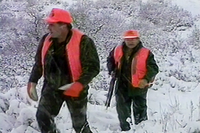
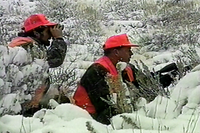
Frostbite
Frostbite is the freezing of a part of the body, most often the nose, ears, cheeks, fingers or toes. Severity of frostbite depends on the air temperature, length of exposure and degree of wind.
Signs & Symptoms
- Lack of feeling in the affected area
- Swelling
- Discolored skin- flushed, waxy, white, yellow or blue
- Blisters
Treatment in the Field
Call 9-1-1 immediately to get emergency medical services (EMS) on the way.
Remove victim from cold exposure, remove clothing from affected body parts and handle gently. Do not rub affected areas! If warm water is available, put parts in warm water (no warmer than 105 degrees Fahrenheit) until thawed and numbness decreases. Wrap parts in dry, sterile dressing. If fingers or toes are frostbitten put gauze between them. Do not give the person ibuprofen or other non-steroidal anti-inflammatory drugs (NSAIDs). Watch for signs of hypothermia.
Caution! Do not attempt to re-warm a frostbitten area if there is a chance that it might refreeze.
Heat-Related Emergencies
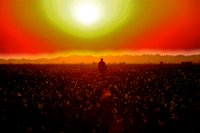
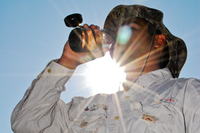
If you haven’t noticed, it can get pretty hot in Texas. Dove hunters can expect hot temperatures in September and it can also be hot later in the year during deer season. If it is hot, you may be the victim of heat cramps, heat exhaustion or, in extreme cases, heat stroke.
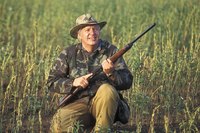
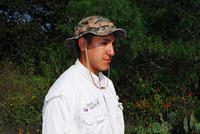
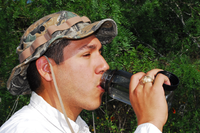
Preventative action is the key to avoiding heat related emergencies.
- Drink plenty of liquids, water is the best choice. Avoid sodas and do not drink alcohol.
- Take breaks and seek out shade
- Wear a hat. One with a brim all the around will be the most comfortable and offers the most protection.
- Dress in layers. A light cotton long-sleeved fishing shirt is a good choice.
- Use sun-block to avoid sunburn.
Heat Cramps
These are the least serious and usually occur in the leg muscles due to loss of body salts (fluids and electrolytes) from heavy perspiration. Move to a cool place, rest affected muscle and give cool liquids such as a sports drink or juice to restore fluids and electrolytes. Do not take salt tablets. Monitor for further signs of heat-related illness.
Heat Exhaustion
This can become serious and is indicated by cold, clammy skin, slightly elevated temperature and possibly loss of consciousness. Move immediately to cool place and elevate legs. If the person is conscious and can swallow, give cool liquids such as a sports drink or juice to restore fluids and electrolytes. Give small amounts, 4 ounces every 15 minutes, don’t let the victim drink too quickly. Seek medical attention as soon as possible.
Heat Stroke
This is the most serious heat-related problem, and the typical symptoms are hot, dry or wet skin, 105° temperature or higher, vomiting, confusion, usually loss of consciousness. Move immediately to cool place and elevate head and shoulders. Call 9-1-1 immediately to get emergency medical services (EMS) on the way. If possible, rapidly cool the body by immersion in cold water or spray the person with cold water or sponge with ice water-soaked towels. After victim is cooled, transport immediately to nearest medical facility.
Heat Stroke is life-threatening! Caution! Be careful not to give liquids orally if victim is unconscious or cannot swallow.
Warning, Hunters - this is only a field guide to treat minor injuries or emergencies. It's the hunter's responsibility to attend a Certified First-Aid and CPR Course.
If you discover an injured person you should:
- Check the area for any dangers
- If the person is unconscious and is face-down, roll face-up, supporting head, neck and back in a straight line.
- Check respiration, begin CPR if indicated
- Check Vital signs: pupils, pulse, skin color, body temperature
- Check level of consciousness and response to stimulus. If they are responsive ask them what happened.
- Initiate a head to toe examination for injury including: head, neck, shoulders, chest, arms, abdomen, back, pelvis, legs & feet
External Bleeding
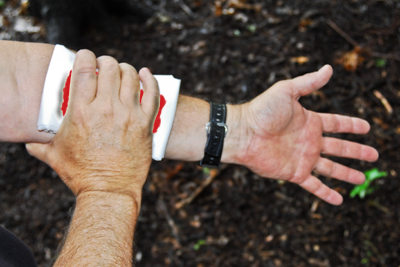
Direct pressure stops most bleeding. Place sterile gauze pad or clean cloth over wound and apply pressure. If bleeding doesn't stop in 5 minutes, place additional pads on the wound and continue to apply direct pressure to the wound. If the pad becomes soaked with blood, apply more bandages and continue pressure. If the injury is to a limb and there is no fracture, elevate the limb above the heart. *Use a tourniquet only as last resort & never apply below the elbow or knee, as this could cause further damage to nerves and vessels that lie near the surface of the skin.
DANGER:
- DO NOT use direct pressure on eye, embedded objects or open fractures
- DO NOT rinse wound with full strength medicines
- DO NOT close wounds with tape
- DO NOT breathe or blow on a wound
Fractures
If a person experiences prolonged pain after an injury and movement in the location of the injury is difficult, there is a good chance they have suffered a bone fracture. You may also notice swelling in this area.
Immobilize the limb by splinting, either by binding the limb to an adjacent limb or by splints. Splint above and below the injury. Materials for splints should be soft or padded. You can use padded metal strips with no sharp edges, padded wooden boards, folded magazines or folded blankets. A triangular piece of cloth works well to make a sling for injured arms. Check for circulation before and after you apply the splint. Look for feeling, warmth and color. Loosen the bindings if the splint is too tight. Seek immediate medical attention.